
Kathryn Logan earned a Doctor of Physical Therapy from Samford’s School of Health Professions in 2019. Today, she serves as an acute care physical therapist at Johns Hopkins Hospital.
As an acute care physical therapist, I work in the hospital with patients who have a variety of medical diagnoses. Prior to the COVID-19 pandemic, I was working on general medicine floors to rehabilitate patients who had difficulty getting out of bed, standing and walking. I saw these patients until they were discharged from the hospital to return home or discharged to continue their rehab in another facility.
Now, I work on a negative pressure COVID-19 unit rehabilitating patients after they leave the ICU. It’s more important than ever to get patients moving again and independent enough to safely quarantine at home. While I’m on the unit, I wear a Powered Air-Purifying Respirator (PAPR) made up of a hood connected by a long tube to a battery-powered air filter strapped around my waist. In between patients, I change disposable gowns and gloves and clean my hands frequently. The hands-on contact I have with my patients during physical therapy has changed a lot due to the contagious nature of COVID-19. Still, we work hard to safely mobilize patients while protecting ourselves from exposure.
I am also a part of a pilot program for telehealth, which was prompted by the COVID-19 pandemic. I spend some afternoons coordinating Zoom meetings with patients who dial in from their rooms. Utilizing this technology, we can provide education on conserving energy in their home, teach breathing exercises and provide a home exercise program to optimize patients’ outcomes while they are recovering from COVID-19.
These are hard and stressful times, but I remind myself that it is a marathon, not a sprint. Caring for yourself allows you to provide the best care for others. We have been called to dedicate our lives to something bigger than ourselves. When we rise to the occasion, we lift everyone up with us.
This mindset and the success stories that I see every day keep me motivated to continue serving my patients. Each week, I work with patients recovering from COVID-19 who make incremental and consistent daily progress until they are able to discharge home. It’s especially inspiring to see patients who have recovered from critical conditions—those who have difficulty even getting out of bed and are now able to walk around their hospital room. I’m also inspired by seeing the curve flatten every day as our efforts to stay home alleviate the burden on health care workers and facilities.
It takes a team of health care professionals working together to progress a patient from critical to discharged. I speak with staff members from different disciplines constantly during the day, from nurses and doctors to respiratory therapists and speech language pathologists. The interprofessional skills we practiced while at Samford’s College of Health Sciences have helped me navigate these collaborations while keeping patient outcomes at the center of our focus.
I am thankful for the many ways Samford’s Doctor of Physical Therapy program prepared me for my first job at Hopkins. Every day, I rely on the foundations of diagnosis and treatment to care for my patients. The fundamental basics of treating pulmonary dysfunction have proven to be crucial in safely mobilizing COVID-19 patients, including monitoring their response to exercise and improving their pulmonary function with breathing techniques.
Samford’s School of Health Professions seeks to tell the stories of our alumni who are working on the frontline of the COVID-19 pandemic. To tell your story, go to our website.
